Ok so first of all, this seems like a really cool site I wouldn't mind learning some more about solid state amps. Unfortunately I'm a bit of an electronics novice (I did some in High school years back but its a bit fuzzy).
Anyway, I'm hoping some of you guys are able to help me out. I was given an amp by a friend a year or so ago, made by his father (given to me shortly after he passed as a gift).
It's a DIY one, with home etched boards by the look of it but i'm sure someone will recognize the design I've used it for a year no worries, really enjoyed it.
I've used it for a year no worries, really enjoyed it.
Anyhow the other day, I was revisiting a 3.5mm --> IR LED cable for triggering DSLRs remotely and I unplugged the amp from my computer to test the cable. When I re-plugged the amp into the computer (both still on), I immediately noticed what sounded a bit like a mains hum. I pulled the plug straight back out, but the hum continued so I switched off the amp. I think I may have hit the wrong 3.5mm socket in the back of the comp but I'm not too sure.
I switched it back on very briefly in the hope that the noise would be gone after a power cycle but no luck. I thought I noted the acrid smell of toasted components too although no visible smoke (amp case has no vents).
Inside it looks like a pretty logical layout, with what I think is more or less identical boards for each channel.
The one marked R looked visually fine
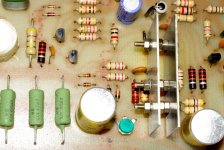
But L had a few roasted resistors.
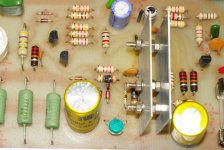
With that in mind I thought, I might just try it quickly with the right channel only - I plugged in my left speaker to the right channel and tried it. It played music but had no bass - I checked and the woofer was not going. I turned it off, and tried the right speaker in the same channel, which was fine woofer and all I was getting good sound out of it - I noticed the acrid smell was increasing, so I turned it off again.
I tested the left speaker with the dead woofer on another amp, same result - but I removed the woofer and tried that alone and it was fine - so the crossover cct in the speaker must've become damaged during that first event?
Anyhow back with the amp I didn't think I could get the underside case off easily to access the back of the PCB, so I did my best to replace the burnt resistors temporarily from the top. I turned it on and immediately one smoked, turned it off again. I then realized the case wasn't riveted and just screwed on the bottom after all
Underneath revealed several more toasted resistors on the bad channel side (including one that didn't give any resistance reading across it at all), and some were starting to look a bit off on the good channel too.
The suspect ones are right about underneath of the K134 transistor pairs (all 100ohm).
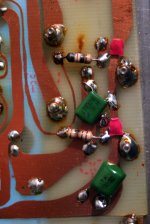
So the questions would be:
What've I likely done to it, did I short the speaker outputs accidentally somehow or is it more likely to be me plugging the 3.5mm jack audio in.
Will replacing all suspect resistors likely help or have I probably fried transistors with it (actually following Speaker Load and Amplifier Failure transistor test guide some are failing when I compare BF470 transistors good channel to bad )
Here is a photo from underneath shows blackened flux around all the transistor legs for both channels but visually they look ok, I guess not quite so.
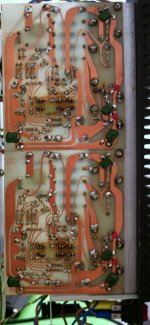
The resistors were carbon, and replacements I sourced are metal film - problemo or no? (they're 1/2 watt and the old ones were 1/4)
Where should I logically be looking for my next step, or is there some simple tests I can carry out with my multimeter prior to potentially re-frying more resistors and transistors?
What style of amp layout is this, and is it any good (I'm suspecting its probably similar to the electronic store kits of the time?)
Can I power the amp up, with the fuses out for the bad channel pcb without doing any harm?
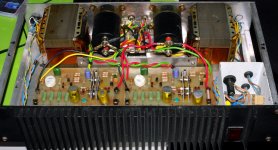
Thanks in advance, I hope to get this thing back up on two feet again. And then work on that pesky speaker crossover. I might be a bit slow off the mark, but at least I'm persistent
Anyway, I'm hoping some of you guys are able to help me out. I was given an amp by a friend a year or so ago, made by his father (given to me shortly after he passed as a gift).
It's a DIY one, with home etched boards by the look of it but i'm sure someone will recognize the design
 I've used it for a year no worries, really enjoyed it.
I've used it for a year no worries, really enjoyed it.Anyhow the other day, I was revisiting a 3.5mm --> IR LED cable for triggering DSLRs remotely and I unplugged the amp from my computer to test the cable. When I re-plugged the amp into the computer (both still on), I immediately noticed what sounded a bit like a mains hum. I pulled the plug straight back out, but the hum continued so I switched off the amp. I think I may have hit the wrong 3.5mm socket in the back of the comp but I'm not too sure.
I switched it back on very briefly in the hope that the noise would be gone after a power cycle but no luck. I thought I noted the acrid smell of toasted components too although no visible smoke (amp case has no vents).
Inside it looks like a pretty logical layout, with what I think is more or less identical boards for each channel.
The one marked R looked visually fine

But L had a few roasted resistors.

With that in mind I thought, I might just try it quickly with the right channel only - I plugged in my left speaker to the right channel and tried it. It played music but had no bass - I checked and the woofer was not going. I turned it off, and tried the right speaker in the same channel, which was fine woofer and all I was getting good sound out of it - I noticed the acrid smell was increasing, so I turned it off again.
I tested the left speaker with the dead woofer on another amp, same result - but I removed the woofer and tried that alone and it was fine - so the crossover cct in the speaker must've become damaged during that first event?
Anyhow back with the amp I didn't think I could get the underside case off easily to access the back of the PCB, so I did my best to replace the burnt resistors temporarily from the top. I turned it on and immediately one smoked, turned it off again. I then realized the case wasn't riveted and just screwed on the bottom after all

Underneath revealed several more toasted resistors on the bad channel side (including one that didn't give any resistance reading across it at all), and some were starting to look a bit off on the good channel too.
The suspect ones are right about underneath of the K134 transistor pairs (all 100ohm).

So the questions would be:
What've I likely done to it, did I short the speaker outputs accidentally somehow or is it more likely to be me plugging the 3.5mm jack audio in.
Will replacing all suspect resistors likely help or have I probably fried transistors with it (actually following Speaker Load and Amplifier Failure transistor test guide some are failing when I compare BF470 transistors good channel to bad )
Here is a photo from underneath shows blackened flux around all the transistor legs for both channels but visually they look ok, I guess not quite so.

The resistors were carbon, and replacements I sourced are metal film - problemo or no? (they're 1/2 watt and the old ones were 1/4)
Where should I logically be looking for my next step, or is there some simple tests I can carry out with my multimeter prior to potentially re-frying more resistors and transistors?
What style of amp layout is this, and is it any good (I'm suspecting its probably similar to the electronic store kits of the time?)
Can I power the amp up, with the fuses out for the bad channel pcb without doing any harm?

Thanks in advance, I hope to get this thing back up on two feet again. And then work on that pesky speaker crossover. I might be a bit slow off the mark, but at least I'm persistent
Will replacing all suspect resistors likely help or have I probably fried transistors with it (actually following Speaker Load and Amplifier Failure transistor test guide some are failing when I compare BF470 transistors good channel to bad )
Unless corresponding resistors on the good channel toast the same shade
of brown, a bad semiconductor or cap fried them. They don't just get up
and burn themselves, and a new set will go up the same way... At least
you have a good channel to check against. Measure for shorts across
caps and semiconductors that don't measure same in the good channel.
Carbon comps might have been right for base stoppers back in the day,
as they had the least inductance. But they were also notorious for
catching fire... Given what happened, I would use metal...
MJE350 might be a slightly easier to find equivalent type for BF470.
Both are: PNP, high voltage, TO126, ECB pinout... BF470 looks better
for high frequency switching circuit, I'd bet they behave no different
at audio frequncy.
Last edited:
Start the amps up via a bulb tester.
Any wiring error makes the bulb glow and the voltage supplied to the mains transformer is lower than rated.
This saves the circuit from any further damage and allows time to measure on board voltages for comparison to the good channel.
Any wiring error makes the bulb glow and the voltage supplied to the mains transformer is lower than rated.
This saves the circuit from any further damage and allows time to measure on board voltages for comparison to the good channel.
oki doki
the person who builted the amp originally made a very good job ...there is only a couple of things that can be done in a better way
then the pcb looks familiar i think i have seen it published in a magazine that will need some searching but if a schematic comes up that can be very usefull
then it is obvious that in the one chanel capacitors have been stressed and will be a nice thing to replace them all to be on the safe side .
obviously there is also thermal stress arround the driver area and close inspection for dry soldering claeaning and so on will be needed
from a short circuit expect outputs to be blown and these type of outputs i think is not longer possible to obtain ( i may be able to do some magic there there a chance in a million that i might be able to locate some for you )
thats a few things to start with ... if you dont have basic understanding arround amplifiers you dont have many chances ... but why not ????
the person who builted the amp originally made a very good job ...there is only a couple of things that can be done in a better way
then the pcb looks familiar i think i have seen it published in a magazine that will need some searching but if a schematic comes up that can be very usefull
then it is obvious that in the one chanel capacitors have been stressed and will be a nice thing to replace them all to be on the safe side .
obviously there is also thermal stress arround the driver area and close inspection for dry soldering claeaning and so on will be needed
from a short circuit expect outputs to be blown and these type of outputs i think is not longer possible to obtain ( i may be able to do some magic there there a chance in a million that i might be able to locate some for you )
thats a few things to start with ... if you dont have basic understanding arround amplifiers you dont have many chances ... but why not ????
I count at least eight bad parts not counting what looks like a popped filter cap on the bad channel. (Cap on left side lower right corner sitting at an angle) Looks like filter cap shorted then moved back up line taking out parts. I'd give a careful check to your output devices as well.
Doc
Doc
Tracking down the hitachi mosfets will be difficult if they are fried. The bf470's can be found, wescomponents has them in their catalogue. Another alternative to the BF470's may be the sanyo 2SA1407.
Electronics Australia designs used to use the BF470/BF469 for drivers.
Tony.
Electronics Australia designs used to use the BF470/BF469 for drivers.
Tony.
http://www.diyaudio.com/forums/solid-state/173430-what-substitutes-you-using-j49-k134.html
Circuit might be clone of this amp?
http://www.hafler.com/techsupport/pdf/DH-200_amp_man.pdf
Circuit might be clone of this amp?
http://www.hafler.com/techsupport/pdf/DH-200_amp_man.pdf
Last edited:
If you get this amp working again, you should see if you can install some power overload protection circuitry. My guess is that whatever happened caused a domino effect that fried many components... although I could be wrong.
Hi, the amp is the ETI 5000 designed by David Tilbrook. The amp modules are project 477 and were described in a series of articles starting Jan 1981. I built one in the early 80s and destroyed it in similar circumstances. If the gate stoppers are damaged then it is almost certain that the fets are toast. Good luck with the repair.
I removed one of the K134 BJT to re-check and make sure the readings i got in-situ weren't bogus, but yeah it seems to be stuffed as are the rest of the ones in the board. The brown crispy resistors were probably enough to work that out anyhow.
Looks like between the BF470's and the K134's the expense might make it a bit of a fruitless venture.
That said though, my GFs father has a degree in electrical engineering she neglected to tell me, and a friend who repairs amps - so I might just get a second opinion anyhow. 🙂
Thanks for all your advice guys, and its good to finally know something about the design of it - i've told the friend of mine too.
I may yet repair it, i'll have to think on it.
Looks like between the BF470's and the K134's the expense might make it a bit of a fruitless venture.
That said though, my GFs father has a degree in electrical engineering she neglected to tell me, and a friend who repairs amps - so I might just get a second opinion anyhow. 🙂
Thanks for all your advice guys, and its good to finally know something about the design of it - i've told the friend of mine too.
I may yet repair it, i'll have to think on it.
My girlfriends father has come and taken a look at it, he believes he might be able to source some of the K134/J49 combo transistors from his contacts back in his home country, which would make this worthwhile. Fingers crossed.
For what its worth, locating the K134 trannies was a fail.
I went with option two, and built a LM3875 gainclone reusing the power supply and casing, heatsinks from this 🙂 I'm pretty pleased overall, sound quality is nice too and the sinks don't get anywhere near as toasty as the ETI did.
Bad speakers crossover wasn't the issue either, voice coil was rubbing I managed to successfully shim it and all is well 🙂
I think i've got some K134/J49 from the good channel here if someone wanted them for postage 🙂
I went with option two, and built a LM3875 gainclone reusing the power supply and casing, heatsinks from this 🙂 I'm pretty pleased overall, sound quality is nice too and the sinks don't get anywhere near as toasty as the ETI did.
Bad speakers crossover wasn't the issue either, voice coil was rubbing I managed to successfully shim it and all is well 🙂
I think i've got some K134/J49 from the good channel here if someone wanted them for postage 🙂
- Status
- Not open for further replies.
- Home
- Amplifiers
- Solid State
- Help! I let some magic smoke out :(